Defence Occupational Health and Safety Strategy 2007-1 - Comcare
Defence Occupational Health and Safety Strategy 2007-1 - Comcare
Defence Occupational Health and Safety Strategy 2007-1 - Comcare
- No tags were found...
Create successful ePaper yourself
Turn your PDF publications into a flip-book with our unique Google optimized e-Paper software.
THE CHANGINGDEFENCE ENVIRONMENT:IMPLICATIONS FOR THEMANAGEMENT OF OHSThe primary role of <strong>Defence</strong> is to provide Governmentwith military options for the conduct of operationsto defend Australia <strong>and</strong> its national interests. Thisresponsibility, together with the dem<strong>and</strong>ing <strong>and</strong>complex nature of the <strong>Defence</strong> environment, givesrise to challenges in meeting our obligation to make<strong>Defence</strong> a safe workplace for our people.First, there is the challenge created by the size <strong>and</strong>geographic spread of the <strong>Defence</strong> workforce. The<strong>Defence</strong> workforce is made up of over 100,000personnel, comprised of:>>permanent <strong>and</strong> reserve force members ofthe Navy, Army <strong>and</strong> Air Force, together withthe cadets from each of the Services;civilianemployees engaged in an ongoing or nonongoing(temporary) capacity under the PublicService Act 1999; <strong>and</strong>private sector contractors working throughout,<strong>and</strong> frequently embedded within, the <strong>Defence</strong>workforce.In addition to working throughout Australia, frommajor metropolitan <strong>and</strong> rural centres to remotelocalities, our people are deployed on operationsoverseas, <strong>and</strong> work in overseas missions,embassies <strong>and</strong> posts throughout the world.There is vast diversity in the nature of workperformed by <strong>Defence</strong> personnel. Militarypersonnel are engaged in ‘warlike’, ‘nonwarlike’<strong>and</strong> ‘peacetime’ operations, includingpeacekeeping <strong>and</strong> humanitarian relief operations,as well as training for such operations. Whileinitial operational training is conducted underthe auspices of the individual Services, we areincreasingly mounting joint ADF operations <strong>and</strong>frequently in coalition with overseas military forces.Support activities performed across <strong>Defence</strong> byboth military <strong>and</strong> civilian personnel encompassan extensive range of functions <strong>and</strong> employmentcategories, including scientifi c, engineering, technical,logistical <strong>and</strong> administrative support together withpolicy development <strong>and</strong> planning. It is fair to saythat <strong>Defence</strong> has a greater range of employmentcategories than any other Australian employer.Overriding all of this, are the risks - in some cases,extreme risks - associated with the nature ofmilitary service. The principal distinguishing featureof military service is, of course, the obligation toserve in combat operations. No other employmentgroup has the same liability. Increased operationaltempo as a result of participation in peacekeeping<strong>and</strong> overseas coalition operations has highlightedthis obligation <strong>and</strong> the inherent risks involved indeployed operations.Despite our desire <strong>and</strong> best efforts to do so, therisks inherent in military service can never becompletely removed. Other than the obvious risksassociated with operational service, ADF trainingactivities are aimed at exercising military skills insimulated combat situations, which by necessityleads to elevated risk environments, albeit wherethe risks are controlled to the maximum extentpracticable. Moreover, many military activitiesrequire personnel to work long <strong>and</strong> irregular hoursof duty in adverse or arduous conditions, thuscompounding the risks.Within this large <strong>and</strong> diverse employmentenvironment the ability to sustain our mostimportant asset - Our People - is paramount.Accordingly OHS becomes a capability enhancerof crucial importance to all personnel. In addition,<strong>and</strong> notwithst<strong>and</strong>ing the unique nature of militaryservice, <strong>Defence</strong> is not immune from complyingwith the OHS Act <strong>and</strong> related legislation. While thedem<strong>and</strong>s made of <strong>Defence</strong> <strong>and</strong> its personnel mayat times be higher than for the rest of the Australianworkforce, the st<strong>and</strong>ards relating to OHS remainthe same as for the wider community.6




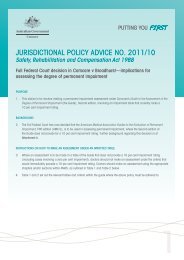
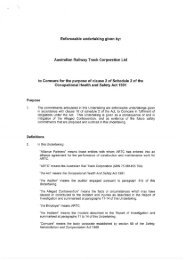

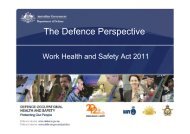
![Notification of demolition work [PDF,151KB] - Comcare](https://img.yumpu.com/49687354/1/184x260/notification-of-demolition-work-pdf151kb-comcare.jpg?quality=85)

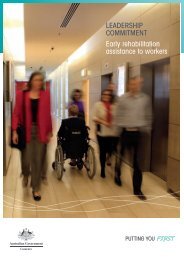

![Better practice guidance to decision making [PDF,672KB] - Comcare](https://img.yumpu.com/45283834/1/184x260/better-practice-guidance-to-decision-making-pdf672kb-comcare.jpg?quality=85)
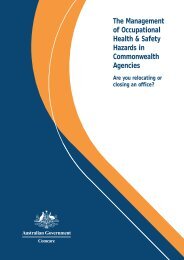

![Manual Handling Consultation paper [pdf] - Comcare](https://img.yumpu.com/42826938/1/184x260/manual-handling-consultation-paper-pdf-comcare.jpg?quality=85)
